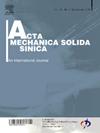Prediction Model of Capacity Degradation in Lithium-Ion Batteries Based on Fatigue Damage Theory and Electrochemical Impedance Spectroscopy
Abstract
The trade-off between mechanistic interpretability, operational convenience, and predictive accuracy is challenging for predicting the lifetime of lithium-ion batteries. To resolve this contradiction, we propose a damage model based on fatigue damage theory and electrochemical impedance spectroscopy. The causal relationship of “fatigue damage → resistance increase → capacity fading” is revealed to describe the underlying mechanism. Charge transfer resistance is chosen as the variable to ensure the convenience of data acquisition. To verify the accuracy of the model, the electrochemical impedance spectrum and capacity of a graphene-coated silicon electrode at two charging rates are collected and analyzed. 50% and 75% of the measured data are utilized as inputs to compare the prediction capabilities of the proposed damage model and the existing empirical model. The particle filter algorithm is adopted to train the parameters of both models. The maximum prediction error of the damage model is less than 3%, showing better prediction accuracy and medium-term prediction stability than the empirical model. Our work demonstrates that the proposed damage model is an effective way to resolve contradictions in lifetime prediction.

 求助内容:
求助内容: 应助结果提醒方式:
应助结果提醒方式:


